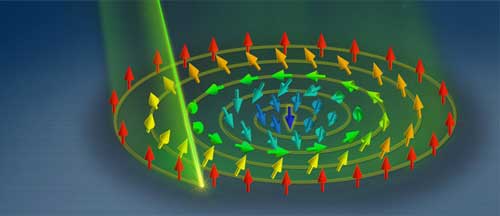| Posted: Apr 06, 2017 |
Skyrmions created with a special spiral
(Nanowerk News) Like baristas creating beautiful spirals of creamy foam on the warm surfaces of lattes, researchers at the U.S. Department of Energy’s (DOE) Argonne National Laboratory have found a way to control the creation of special textured surfaces in magnetically ordered materials.
|
|
While a barista physically spins milk to generate foam for a latte, Argonne researchers investigated novel regions that involve magnetic spins. These regions, known as skyrmions or antiskyrmions, have no net electric charge but do have what scientists call a “topological charge,” which means that they can be used to store information.
|
|
“People have created skyrmions before,” said Argonne Distinguished Fellow Amanda Petford-Long, an author of the study. “But all the research that has been done to date involved their spontaneous formation. What’s new is that we can now control where they occur in a material.”
|
 |
| Argonne researchers have created skyrmions – ordered regions of magnetic spins – by using a spiraling focused ion beam. (Illustration: Robert Horn / Argonne National Laboratory)
|
|
To create their skyrmions and antiskyrmions, the researchers used a focused ion beam, which essentially bombarded the surface of layers of platinum and cobalt with gallium ions. “You can almost think of it like a chef using a brulee torch, but instead of using heat we’re using another material,” said Argonne materials scientist Charudatta Phatak, a lead author of the study (Scientific Reports, "Creation of artificial skyrmions and antiskyrmions by anisotropy engineering").
|
|
How the researchers decided to move the ion beam on the surface dramatically influenced the kinds of structures that resulted. First, they tried a method known as “raster scanning,” which involved moving the beam back and forth vertically or horizontally. This failed to produce the desired skyrmions or antiskyrmions.
|
|
Eventually, the team hit on the idea of moving the beam in a spiral, either starting from the center and working outward or from the edges and moving towards the center. In the first case, this produced a very nicely defined skyrmion; in the second case, the researchers found that the inward spiral produced an antiskyrmion. “To the best of our knowledge, this is the first time an artificial antiskyrmion has been realized by experiment,” Phatak said.
|
|
Because this method creates skyrmions and antiskyrmions that are fixed in position, future research could use this advance to create a kind of “pinball machine” for electrons that would use the imprinted magnetic spins in the skyrmion regions to direct electron motion.
|
|
“What’s really exciting is the ability to study the interactions of these structures,” Petford-Long said. “Our research opens many new possibilities for exploring new fundamental physics, because using the ion beam allows us to make skyrmions and skyrmion-like structures with various sizes ranging from nanometers to microns.”
|

